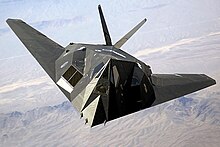
Stealth aircraft are aircraft that use stealth technology to avoid detection by employing a combination of features to interfere with radar as well as reduce visibility in the infrared, visual, audio, and radio frequency (RF) spectrum. Development of stealth technology likely began in Germany during World War II. Well-known modern examples of stealth aircraft include the United States' F-117 Nighthawk (1981–2008), the B-2 Spirit, the F-22 Raptor, and the F-35 Lightning II.
While no aircraft is totally invisible to radar, stealth aircraft prevent conventional radar from detecting or tracking the aircraft effectively, reducing the odds of a successful attack. Stealth is the combination of passive low observable (LO) features and active emitters such as Low Probability of Intercept Radars, radios and laser designators. These are usually combined with active defenses such as chaff, flares, and ECM. It is accomplished by using a complex design philosophy to reduce the ability of an opponent's sensors to detect, track, or attack the stealth aircraft. This philosophy also takes into account the heat, sound, and other emissions of the aircraft as these can also be used to locate it.
Full-size stealth combat aircraft demonstrators have been flown by the United States (in 1977), Russia (in 2010) and China (in 2011), while the US Military has already adopted three stealth designs, and is preparing to adopt another.
Most recent fighter designs will at least claim to have some sort of stealth, low observable, reduced RCS or radar jamming capability, but as of yet there has been no actual air to air combat experience against stealth aircraft.